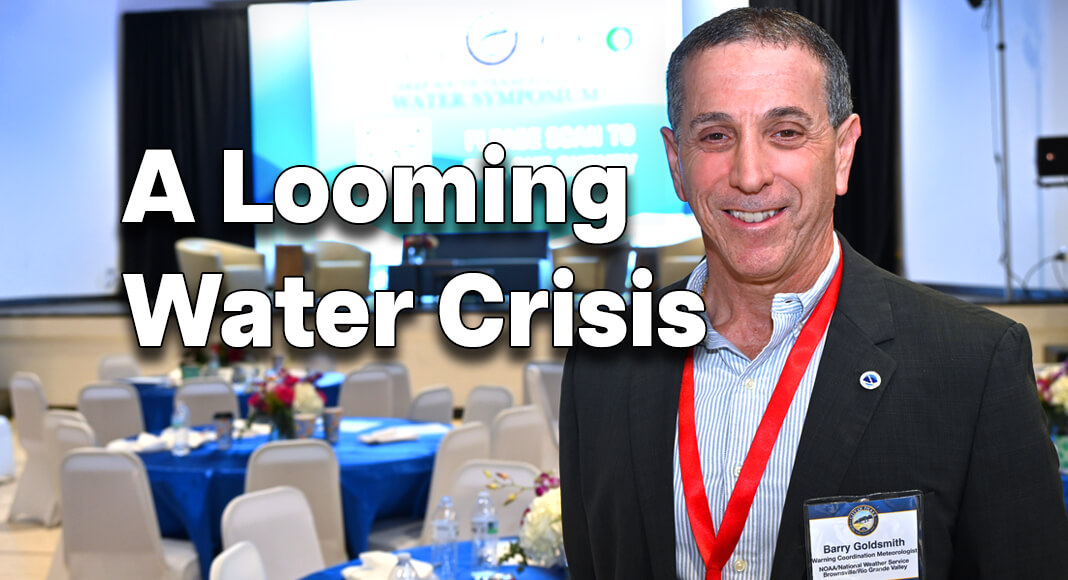
Texas Border Business
By Roberto Hugo González
The Rio Grande Valley is currently experiencing a severe water crisis, which has been exacerbated by rapid population growth, extreme weather events, and the complexities of international water agreements. On August 20, 2024, Pharr, Texas, hosted the Deep South Texas State of Water Symposium, a crucial event aimed at tackling these escalating water challenges in the region.
The symposium, organized by State Representative Terry Canales and State Senator Juan “Chuy” Hinojosa, brought together federal, state, and local legislators, community leaders, and water experts to confront the Valley’s most pressing water issues. Among the key attendees was Barry Goldsmith, a Warning Coordination Meteorologist at the National Weather Service in Brownsville, who provided crucial insights into the future of the region’s water resources.
Goldsmith, who has nearly 17 years of experience in the Valley and over 38 years in meteorology, painted a sobering picture of the situation during an interview at the symposium. With Texas Border Business. He emphasized the dire nature of the crisis, stating, “The unpredictability of hurricanes—events critical for replenishing the Valley’s water reservoirs—leaves us in a precarious position.” He further warned, “We’re still watching for the Caribbean, the Western Atlantic, and the Gulf of Mexico, probably for the next 30 days into mid to late September,” but added a stark caution: “The odds of a significant storm hitting the region are decreasing. The clock is ticking against us rather than for us because the weather pattern has not been favorable.”
Goldsmith provided alarming statistics on water levels in the region’s major reservoirs. “As of the latest reports,” he noted, “Amistad Reservoir is at just below 20% of its total capacity, and Falcon Lake is even lower, at approximately 11.5% capacity.” He emphasized that these figures, representing the total water capacity shared between the U.S. and Mexico, directly result from “insufficient rainfall, unfavorable weather patterns, and increased water demand from both sides of the border.”
In response to the critical water shortage, Goldsmith advocated for a comprehensive conservation strategy called the “Five Asians” approach. “Conservation is key,” he stated, urging people to reduce water usage in daily activities, such as taking shorter showers and limiting outdoor watering. He stressed the importance of “Reclamation—recycling and reusing water to maximize the existing supply” and emphasized the need for “Desalination—investing in technologies to convert seawater into freshwater could provide a new water source for the region.” He also called for smarter irrigation methods, saying, “Irrigation practices must evolve. Drip irrigation can significantly reduce water waste in agriculture.” Finally, he underlined the role of “Innovation—exploring and developing new technologies and strategies to address the ongoing water crisis.”
Goldsmith highlighted rainwater harvesting as a viable supplementary method for non-potable water needs. “When appropriately managed,” he explained, “this technique could provide an additional buffer against the increasingly scarce water supply.”
He also discussed the erratic weather patterns that characterize the Rio Grande Valley, where periods of severe drought are often followed by intense flooding. “This dual threat poses unique challenges for water management in the region,” Goldsmith said. While conservation and technological innovation are critical, he stressed the importance of improving drainage systems to handle the inevitable heavy rains. “We must continue our drainage improvements to handle the water that will come when it rains hard,” he urged, emphasizing that communities must invest in infrastructure that can prevent flooding and protect properties.
The water crisis has already begun to take a toll on the Valley’s agriculture, a key industry in the region. Goldsmith pointed out that the sugar industry, once a significant part of the local economy, “has been severely impacted by the lack of water.” Similarly, he warned that “the citrus industry is at risk, with its survival dependent on adopting more efficient irrigation methods.” He argued that “traditional flood irrigation methods are no longer sustainable due to rising temperatures and increased evaporation rates.” He said that transitioning to drip irrigation and other water-saving techniques “could be essential for preserving these industries.”
Goldsmith’s comments at the Deep South Texas State of Water Symposium stress the urgency of the Rio Grande Valley’s water crisis. “With reservoir levels at historic lows and no significant rainfall on the horizon, the region must act swiftly to implement comprehensive water conservation strategies,” he urged.
Goldsmith suggested that the combination of conservation, reclamation, desalination, smart irrigation, and innovation “offers a potential path forward, but time is running out.” He warned that without immediate and coordinated action, “the Valley could face severe economic and social consequences as water supplies dwindle.”
The symposium served as a platform for discussion and a call to action. “The Rio Grande Valley’s residents, industries, and governments must come together to address this crisis before it is too late,” Goldsmith said, summing up the urgency of the moment. “We must find solutions today to ensure we have water tomorrow.”
See related stories:














